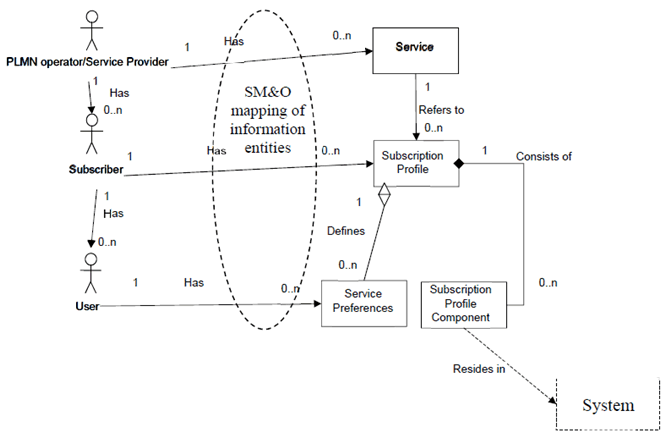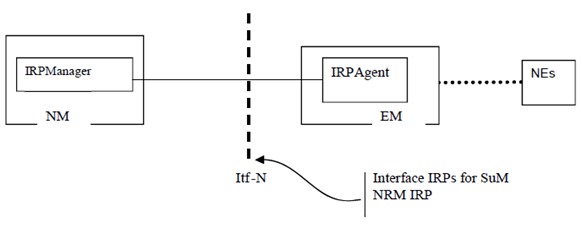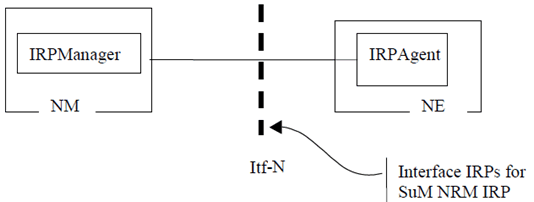TS 32.141
Telecommunication Management –
Subscription Management (SuM) architecture
V18.0.0 (PDF)
2024/03 15 p.
V17.0.0
2022/03 15 p.
V16.0.0
2020/06 15 p.
V15.0.0
2018/06 15 p.
V14.0.0
2017/03 15 p.
V13.0.0
2016/01 15 p.
V12.0.0
2014/10 15 p.
V11.1.0
2013/06 15 p.
V10.0.0
2011/04 14 p.
V9.0.0
2009/10 14 p.
V8.0.0
2008/12 14 p.
V7.0.0
2007/06 14 p.
V6.1.0
2004/03 14 p.
- Rapporteur:
- Mr. Heskin, Eamon
Deutsche Telekom AG
Content for TS 32.141 Word version: 18.0.0
0 Introduction p. 4
The present document is part a TS-family covering the 3rd Generation Partnership Project; Technical Specification Group Services and System Aspects; Telecommunication management, as identified below:
TS 32.140:
The 3G environment requires more complex service delivery mechanisms and is no longer simply an internal matter for a single operator but a capability that is achieved by linking together features across multiple service providers and operators. Subscription Management (SuM) is a feature that permits Service Providers, Value Added Service Providers, and Mobile Operators to provision services for a specific subscriber. The feature is necessary to allow service providers and operators to provision, control, monitor and bill the configuration of services that they offer to their subscribers.
For further details see TS 32.140 on SuM requirements that gives an overview of SuM.
"Subscription Management (SuM) requirements".
TS 32.141:
"Subscription Management (SuM) architecture".
TS 32.171:
"Subscription Management (SuM) Network Resource Model (NRM) Integration Reference Point (IRP): Requirements".
TS 32.172:
"Subscription Management (SuM) Network Resource Model (NRM) Integration Reference Point (IRP): Information Service (IS)".
TS 32.176:
"Subscription Management (SuM) Network Resource Model (NRM) Integration Reference Point (IRP); Solution Set (SS) definitions".
TS 28.751:
"Subscription Management (SuM) Network Resource Model (NRM) Integration Reference Point (IRP): Requirements".
TS 28.752:
"Subscription Management (SuM) Network Resource Model (NRM) Integration Reference Point (IRP): Information Service (IS)".
TS 28.753:
"Subscription Management (SuM) Network Resource Model (NRM) Integration Reference Point (IRP); Solution Sets (SS) definitions".
1 Scope p. 5
The present document defines the architecture for Subscription Management (SuM) , including Converged Management of fixed and mobile networks.
2 References p. 5
The following documents contain provisions which, through reference in this text, constitute provisions of the present document.
- References are either specific (identified by date of publication, edition number, version number, etc.) or non-specific.
- For a specific reference, subsequent revisions do not apply.
- For a non-specific reference, the latest version applies. In the case of a reference to a 3GPP document (including a GSM document), a non-specific reference implicitly refers to the latest version of that document in the same Release as the present document.
[1]
TR 21.905: "Vocabulary for 3GPP Specifications".
[2]
TS 23.002: "Network Architecture".
[3]
TS 32.101: "Telecommunication management; Principles and high level requirements".
[4]
TS 32.102: "Telecommunication management; Architecture".
[5]
TS 32.140: "Telecommunication management; Subscription Management (SuM) requirements".
[6]
TS 23.008: "Organization of subscriber data".
[7]
TS 32.150: "Integration Reference Point (IRP) Concept and definitions".
3 Definitions and abbreviations p. 5
3.1 Definitions p. 5
For the purposes of the present document, the following terms and definitions apply:
subscriber:
See TR 21.905.
service:
See TR 21.905.
Integration Reference Point (IRP):
See TS 32.101.
user:
See TR 21.905.
subscription:
See TR 21.905.
Subscription Management (SuM):
See TR 32.140.
Subscription Profile:
See TR 32.140.
Subscription Profile Component:
See TR 32.140.
3.2 Abbreviations p. 6
For the purposes of the present document, the following abbreviations apply:
2G
Second Generation Mobile
3G
Third Generation Mobile
API
Application Programming Interface
ASP
Application Service Provider
AuC
Authentication Center
B2B
Business to Business
CS
Circuit Switch
EIR
Equipment Identity Register
GTT
Global Text Telephony
GUP
Generic User Profile
HE
Home Environment
HLR
Home Location Register
HSS
Home Subscriber Server
IMS
IP Multimedia Subsystem
IRP
Integration Reference Point (TS 32.102)
ISP
Internet Service Provider
NPDB
Number Portability Data Base
NRM
Network Resource Model
OAM
Operations, Administration and Maintenance
OSA
Open Services Access
OSF
Operations System Functions
OSS
Operations Support System
PS
Packet Switch
SLA
Service Level Agreement
SM&O
Service Management and Operations (TMF/ITU-T)
SP
Service Provider
SuM
Subscription Management
TMN
Telecommunication Management Network
TR-IRP
Trading Partner IRP
UICC
Universal Integrated Circuit Card
USIM
Universal Subscriber Identity Module
VASP
Value Added Service Provider
VHE
Virtual Home Environment
VNO
Virtual Network Operator
4 Subscription Management (SuM) architecture p. 6
3G Telecommunication Management focuses on the most important and strategic contexts in the physical architecture for the management of UMTS. The framework to help define a telecom management physical architecture for a planned UMTS and to adopt standards and provide products that are easy to integrate is defined in TS 32.102.
SuM manages Subscription Profile Components stored in network resources for the purpose of providing services to specific subscribers. This is done with an architecture that is consistent with the one specified in TS 32.102.
Subscription Profiles represent services and are associated to subscribers that employ these services (TS 32.140). To the extent the HSS controls certain services, Subscription Profile Components can be associated with the HSS. Other services, and as a result Subscription Profiles Components, are outside the jurisdiction of the HSS.
4.1 Functional entities p. 7
Functional entities belonging to SuM are described in Figure 1. The figure also contains the actors related to Subscriptions.

Actors described in Figure 1 are:
- Subscriber (definition See TR 21.905)
- User (definition See TR 21.905)
- Service Provider (definition See TR 21.905)
- PLMN Operator (definition See TR 21.905)
- Subscription Profile (definition See TS 32.140)
- Subscription Profile Component (definition See TS 32.140)
- Service (definition See TR 21.905)
- System (definition See TS 32.102)
- Service Preferences: Contains the service preferences chosen for a user. Each user configures his preferences for a particular subscribed service, but only within the limits defined by the Subscription.
- A PLMN Operator/Service Provider has one or several Services to offer for Subscribers.
- A Subscriber has one or several Subscription Profiles, where each describes an offered Service.
- A User has one or several Service Preferences, where each describes the user's chosen preferences for the service.
- A Subscription Profile may consist of one or several Subscription Profile Components.
- A Subscription Profile may define one or several Service Preferences.
- A Subscription Profile Component resides in one or several systems
- Subscriptions are managed in the form of Subscription profile components, which may be distributed across Service Management & Operations (SM&O), Network Resource Management & Operations (RM&O) and Network Domains. There may also be mappings among the SM&O, RM&O and Network Domains.
4.2 Interfaces p. 8
4.2.1 Application of Itf-N for SuM p. 8
![Copy of original 3GPP image for 3GPP TS 32.141, Fig. 2: Overview of PLMN Telecom Management Domains and Itf-N (3GPP TS 32.102 [4])](./img/tinv-32-141-2.gif)
Figure 2: Overview of PLMN Telecom Management Domains and Itf-N (3GPP TS 32.102 [4])
(⇒ copy of original 3GPP image)
(⇒ copy of original 3GPP image)
The Itf-N for SuM is realized by means of an Integration Reference Point (IRP) as defined in TS 32.102.
Operations System Functions (OSF) functionality can be realized in NEs or in the NE Management systems. SuM, for this release, is concerned with the OSF functionality contained in the Core Network Basic Entities Domain and specifically that of the Common CN Domain. Subscription Profile Components are located in the NEs OSF's within the Common CN Domain or their NEs OSF's in the NE management systems, and are in either case accessed consistent with the IRP concept. SuM OSF's for Network Management and Service Management are located in network- and service management systems.
4.2.2 Void
4.3 Overview of IRP p. 8
Figures 3 and 4 identify system contexts of the IRP in terms of its implementation, called IRPAgent (see TS 32.150), and the user of the IRPAgent, called IRPManager (see TS 32.150).
The IRPAgent implements and supports the Interface IRPs for SuM NRM IRP. The IRPAgent can reside in an Element Manager (EM) or a Network Element (NE) (TS 32.102). In the former case, the interface (represented by a thick dotted line) between the EM and the NEs is not the subject of the Interface IRPs for SuM NRM IRP.
An IRPManager using the Interface IRPs for SuM NRM IRP shall choose one of the two System Contexts defined here, for each NE. For instance, if an EM is responsible for managing a number of NEs, the NM shall access the Interface IRPs for SuM NRM IRP through the EM and not directly to those NEs.
The interface IRPs for SuM NRM IRP can be the following:
- Basic CM IRP


4.3.1 IRP security p. 9
The IRP interface is made secure by controlling access to the network and management systems. Operations processes must insure that only authorized personnel have the access authority to retrieve and alter SuM data. Standard protocols used over the interface between the IRPManager and the IRPAgent provide some degree of security. The exact nature of the security is described in the Solution Set for that protocol. In addition to the requirement that the IRPManager and the IRPAgent be secure, most physical links between them are secured as well.
4.4 Methodology p. 9
The methodology used to conclude the standard work for SuM shall follow the IRP methodology described in TS 32.150. This subclause describes how to apply that methodology.
4.4.1 SuM Stage 1 p. 9
SuM Stage 1 is documented in TS 32.140.
4.4.2 SuM Stage 2 p. 9
SuM Stage 2 is documented as follows:
- The present document (3GPP TS 32.141) is finalized by identifying the relevant IRPs.
- 3GPP TS 32.171 (for non-converged management) and TS 28.751 (for converged management) define the Requirements for the SuM NRM IRP. 3GPP TS 32.171 and TS 28.751 shall, where applicable, follow the structure in 3GPP TS 32.621 (for non-converged management) and TS 28.621 (for converged management) (Generic NRM IRP: Requirements) , respectively.
- 3GPP TS 32.172 (for non-converged management) and TS 28.752 (for converged management) describe the Information Service for the SuM NRM IRP - containing the Information Object Classes (IOCs), attributes, relations etc. for SuM.
4.4.3 SuM Stage 3 p. 10
SuM Stage 3 is documented in the following documents:
- TS 32.176 (for non-converged management) and TS 28.623 (for converged management) SuM NRM IRP: Solution Set definition s.